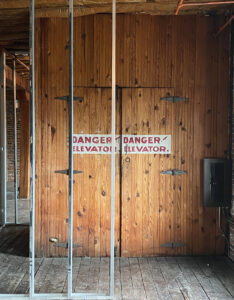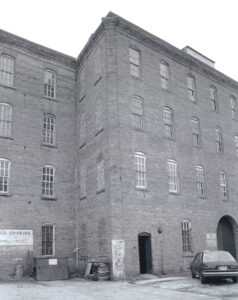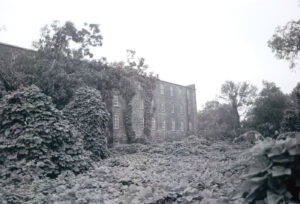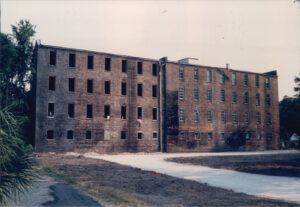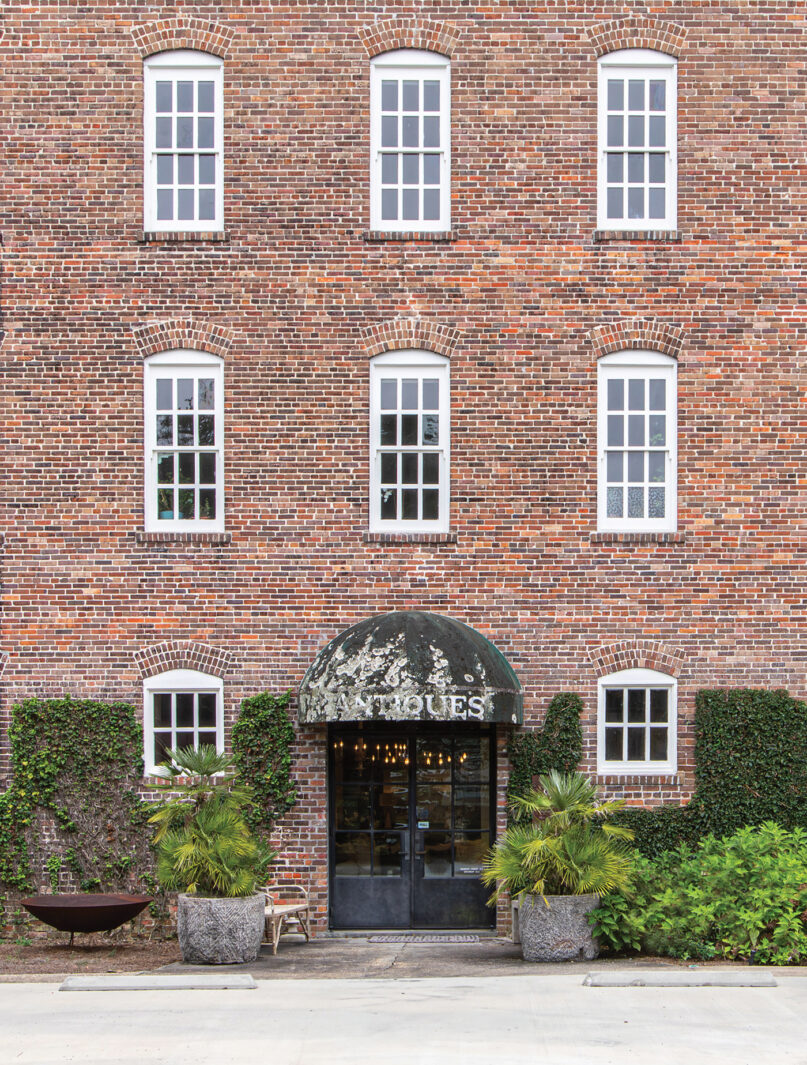
The gravel driveway leading to the building is shaded by oak trees that Tony transplanted from another family property. // Photos by Laura Rowe
There’s a red brick edifice that peeks through the oak tree canopy between Dauphin and Conti Streets, its true splendor only revealed by driving up a gravel pathway. Its charm lies in the details: white window frames set under clay and mortar arches, ivy fixed to the timeworn masonry and grand, awning-shielded entryways that are the only vestiges of the building’s original wooden doors. The building’s present facade reveals nothing about its past life as an abandoned, blight-stricken relic. Its renewal was made possible by the vision and dedication of the Atchison family, who saw potential hidden in the decay and committed to restoring the old structure for their family business.
Atchison Home, a locally-renowned interiors and design shop, was born in a different cradle on Government Street before it settled into the historic brick warehouse on Dauphin Street, but with the passage of time came the need for change. Tony Atchison decided to relocate the family business in the 1980s, but he struggled to find a space that spoke to him. “I needed to find a place to put the store, and around that time, I got together with a friend who just got back from Dallas,” Tony recalls. “He told me, ‘Y’all need to put the store in one of those old brick buildings that they’re doing out there. They’re putting businesses in them.’ And I said, ‘Well, where is one?’ He told me all about the place. I came over here and looked at it Friday and then bought it on Monday. You know, it was reasonable — it was just what we needed.”
In choosing the new location for Atchison Home, Tony found a building with a long history that dovetailed with his own. Built in 1907, the four-story brick warehouse in the Old Dauphin Way Historic District was originally known as the Walker Warehouse, named for its builder Harold Spencer Walker. He, like the Atchisons, dedicated the space to home furnishings and furniture. The Walker Furniture Storage and Moving Company operated out of the building for decades, never contemporizing beyond the original construction. As the rest of the world embraced modern amenities like mechanical elevators and secure storage systems, the Walker Furniture Storage and Moving Company’s business model became untenable. The business shuttered and remained unoccupied for several years before the warehouse caught the Atchisons’ eyes.
The once-grand structure fell into disrepair after a period of vacancy. The Atchisons, who have long been committed to the revitalization and preservation of Mobile’s historic districts, felt called to revive it. “The building was just a rough, rustic mess,” says Tony. “We closed the store for three months, and we stabilized and renovated the first two floors — enough to put the store in it. The whole renovation took a while, though. We used to have a house over on Dauphin Street, but we sold that and put that money into this and moved into a house on this property that came with the deal, fixing it up and living in it while we worked on the building.”
Left to right The shaft for the original freight elevator. The back of the Walker warehouse prior to the Atchisons’ restoration in the 1980s. Images courtesy the Atchison family
The years of labor and restoration were a family effort. Tony’s son and real estate developer Taylor Atchison learned about historic preservation at the foot of a ladder. “My grandfather partnered with my dad when he bought the building in the ’80s, and my earliest memories happened around this building,” says Taylor. “We moved into the house when I was probably 4 or 5, and we lived there until I was probably 13 or 14. I remember going into my grandfather’s office to see him, and we still have the piece of wood where we’d measure our heights in his office. We have a picture of a 5-year-old me chipping paint. I wanted to work one day, so I just started scraping paint. It’s a unique thing to, as a kid, be within steps of where your grandfather and your dad work.”
As fond as the Atchisons were of the house in the shadow of their red clay colossus, they eventually decided it was time to move on to a new family home. But having spent years restoring the old warehouse according to their vision, they struggled to find something that spoke to them. “We lived in the house while we worked on the building, and then we started looking for somewhere to move and couldn’t find anything that we were happy with,” Tony says. Their long search ended with a stroke of genius, and the family decided to make Atchison Home the new Atchison home. “We built a house on the right side of the building — the first two floors and a little bit of the third floor, but it turned out great.”
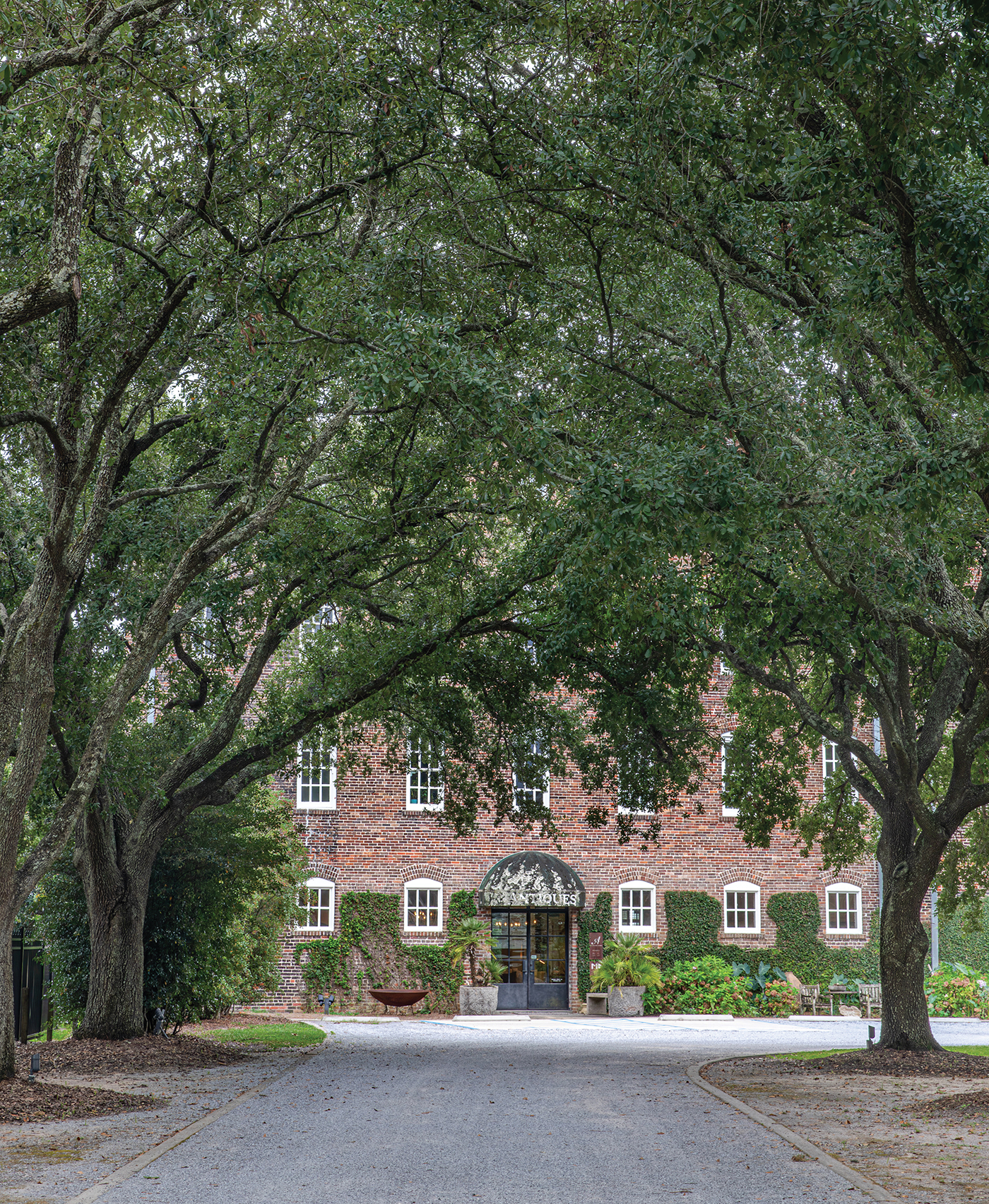
The gravel driveway leading to the building is shaded by oak trees that Tony transplanted from another family property.
Most of the alterations made to the property were standard, necessary modifications for modern living, but some were made to better suit the residents’ desires. The building’s freight elevator with a pulley system, while charming, was upgraded to a mechanical one so that groceries could be carried to the upper levels without having to balance bags on one arm and tug a rope with the other. The corral behind the building was removed since a horse was obviously no longer living on the premises, and the sliding wood entrance door to the store was replaced with a glass one that sealed in the air conditioning. Some of the more poignant additions to the parcel were the oak trees the Atchisons transplanted from a beloved family property — a gesture that will forever tie them to the grand old warehouse. The Atchisons were so taken by their warehouse quarters that they eventually converted more areas of the upper floors into the Atchison Lofts, allowing other Mobilians to experience first-hand what made life in the building so remarkable.
A lifetime of learning about structural restoration through his family’s work on the Atchison Home edifice inspired Taylor’s fervor for Mobile’s historic buildings, and he’s drawn from that foundation to revitalize the Midtown and Downtown areas. “In its heyday, Downtown was vibrant. My first memories are of living Downtown,” Taylor says. “I was really the only kid in my friend group that lived in the area, and we would ride bikes past a bunch of boarded-up buildings. I’ve just always had a passion for urbanism and want it to be vibrant. I feel lucky that I was given an opportunity to watch my dad and learn from my family how to be good stewards of the community.”
Left to right The Walker Warehouse was covered in kudzu before it was transformed into Atchison Home in the 1980s. Many of the windows were missing and had to be replaced with new sills that matched the originals. Images courtesy the Atchison family.
From century-old homes to restaurants and bars, the Atchisons have left their mark on Mobile. “I think it’s fun to leave these legacies around,” says Tony. “And I hope the kids in the family will keep them going after this. That’s part of the pleasure in all this.”
Building a legacy worth passing down is about embracing challenges, knowing that it’s grit and perseverance that will make it last. “What we do is hard, hard work,” says Taylor. “It’s complicated, and it’s not as easy as, you know, building a metal building for a dollar store, but it’s just more of a lifestyle. The remaining, enduring part of it is the reason we do it.”

